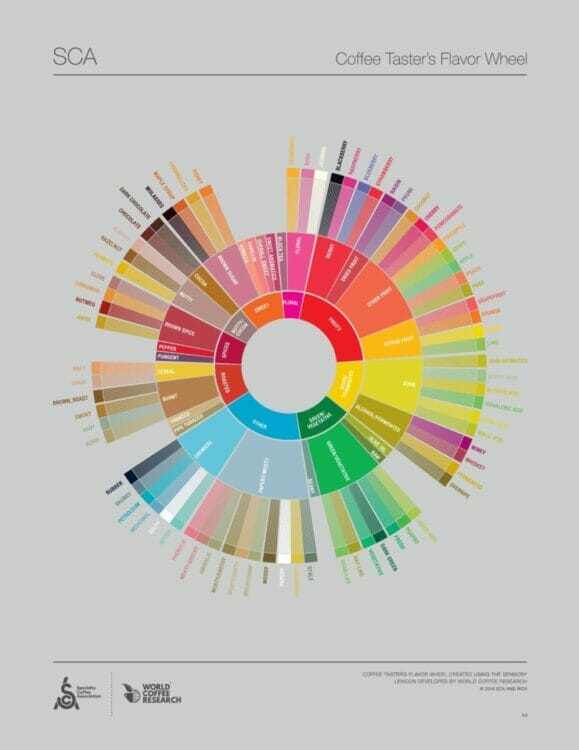
Why can experienced coffee tasters distinguish many coffee flavors, but the vast majority of users can't describe the notes they perceive? Or why can they describe some notes, but not as accurately as coffee tasters? These questions are frequently asked in the industry. Let's analyze how the sense of taste works and how the brain analyzes flavor.
For starters, it's hard to know whether something tastes good or not, as many factors influence how we perceive things, such as smell, pharmacological effects, temperature, vision, environment, atmosphere, etc. Some people also have different tastes due to their genes, which is why some people may hate cilantro or cauliflower.
Just like wine tasting, many factors influence the flavor of coffee, such as the origin of the beans, the production method, and the type of processing. By tasting different types of coffee, you can appreciate the differences in the flavor and quality of the beans. Just as a wine connoisseur can distinguish between different regions and grape varieties, a coffee connoisseur can appreciate the differences between different origins and different production processes.
Human taste is basically divided into five categories: sour, sweet, bitter, salty, and umami (the taste of amino acids and proteins). In addition, there is spiciness, which is a kind of painful sensation and can be very different depending on the food that produces it, but it is not a taste. It produces a dryness or tightness in the mouth, which is what we feel when oral protein breaks down.
The human body has between 4,000 and 5,000 taste buds, half of which are located at the root of the tongue. There are also between 2,000 and 5,000 taste buds from the depths of the mouth to the throat.
Understanding how our brain interprets the taste of coffee.
When coffee reaches your mouth and touches your taste buds, it sends signals to your brain, which then interprets these signals to determine whether the coffee tastes sour, sweet, or bitter. However, we often say that a cup of coffee tastes like honey or flowers—how can that be if there are only five flavors? This is primarily due to your sense of smell. Although the human sense of smell isn't as keen as a dog's, it's still very sensitive. The flavors in coffee evaporate and combine with the olfactory organs at the back of your nose to create what we call "flavors." The combination of smell and taste signals is very complex, and your brain requires long-term training to distinguish all the combinations of signals in detail. This is why coffee tasters and chefs have specialized training in recognizing different flavors and smells.
If you're unable to detect the subtle flavors of coffee or can't taste some of the flavors in dishes mentioned by others, it's not necessarily because your sense of taste and smell are impaired. It's simply because your brain doesn't recognize or interpret those smells. For example, if I tell you that a cup of coffee smells like Earl Grey (a type of black tea, usually of Indian origin, flavored with bergamot essential oils), you may not know what I'm talking about. Therefore, the brain needs training to be able to recognize and distinguish different flavors and smells, which is also part of the training for coffee tasters.
The rise of the coffee flavor wheel.
Basically, the problem that the color red we see can be different for each person also applies to the sense of taste. When we eat something with the same flavor, we may have different interpretations of how that food tastes. To solve this problem, the coffee industry has created something called a "flavor wheel" that helps everyone communicate and better understand what they are drinking or smelling. In 2016, the SCA made some changes to the original flavor wheel published in 1995. This helps everyone speak the same language when referring to the different flavors of coffee.

The coffee "flavor wheel" has been carefully designed to show which flavors are closest to each other and which are less similar. Typically, adjacent flavors on the map are more closely related to each other, while opposite flavors are less similar. If you're not sure how to describe the flavor of a cup of coffee, you can use the flavor wheel as a guide to help you find the right words. It's a useful tool to ensure we're all speaking the same language when referring to the different flavors of coffee.
How to expand your flavor vocabulary.
When coffee tasters evaluate the flavor of a sample, they often sip the coffee vigorously to turn the liquid into many small droplets that coat all the taste buds in the mouth. However, this can be very noisy and may be inappropriate in a coffee shop, as the shop owner or other customers may think you're a professional or trying to be annoying. Instead, it's recommended to sip the coffee slowly, allowing the liquid to flow throughout your mouth and moisten every cell.
To improve your flavor vocabulary and learn to better describe what you're drinking or eating, you can practice tasting different foods and fruits in your daily life, such as oranges, grapes, mangoes, berries, plums, peaches, lychees, red wine, nuts, caramel, and honey. It's also important to have an open mind and be willing to try unusual or unfamiliar foods that may come your way.

The Flavors of Coffee: Why Is Bitterness King?
In the book "THE CRAFT AND SCIENCE OF COFFEE," it is mentioned that bitterness is one of the main components of coffee flavor. Humans, who originally rejected bitterness and acidity, have learned to enjoy these flavors through culture and experience. Each person has a different tolerance for bitterness and can accept various levels in different foods. For example, Taiwanese are accustomed to eating fermented foods like soy sauce or fermented tofu, so they can easily accept the fermented flavor of some types of coffees with natural processes and more exotic profiles. Westerners, on the other hand, tend to place a greater emphasis on the original flavor of foods and prefer cleaner, more acidic, and brighter flavors.
In the past, most people drank Arabica coffee beans, which have a variety of fruity and acidic flavors. However, over time and under the influence of marketing, people began to associate the taste of coffee with bitterness, and coffee is expected to have a strong, bitter taste. As a result, the original Arabica coffee beans with acidic flavors are considered strange.
Subjective taste and smell in specialty coffee: Why it's important to be open to trying different flavors.
The acidic taste of specialty coffee can cause saliva to be released, which can help the taste buds perceive more flavors. When the liquid enters the mouth, it is washed away by saliva. If it is washed away more quickly, it will have a clearer taste, and if it is washed away more slowly, it will have a lingering aftertaste. Some flavors, such as sweetness and acidity, are very prominent in coffee and disappear quickly after being perceived, which can provide a refreshing sensation. Other flavors, such as jasmine aroma, grapefruit flavor, and nutty flavor, will have a lingering aftertaste.
Acids can be divided into good acids and bad acids. The good acids we like in our specialty coffee are those that resemble fruits. A bad acid would be, for example, the acid from a defective bean. Some people don't like the acidity of specialty coffee. Others simply don't like acidity.
Finally, it's important to keep in mind that coffee's acidity and sweetness are two characteristics that can significantly affect its flavor and should be considered when choosing and preparing the perfect coffee for each person. It's also important to remember that taste and smell are two very subjective senses and can vary greatly from person to person. Therefore, it's important to be open to trying different flavors and be willing to learn more about them in order to fully enjoy coffee and all its complexities.